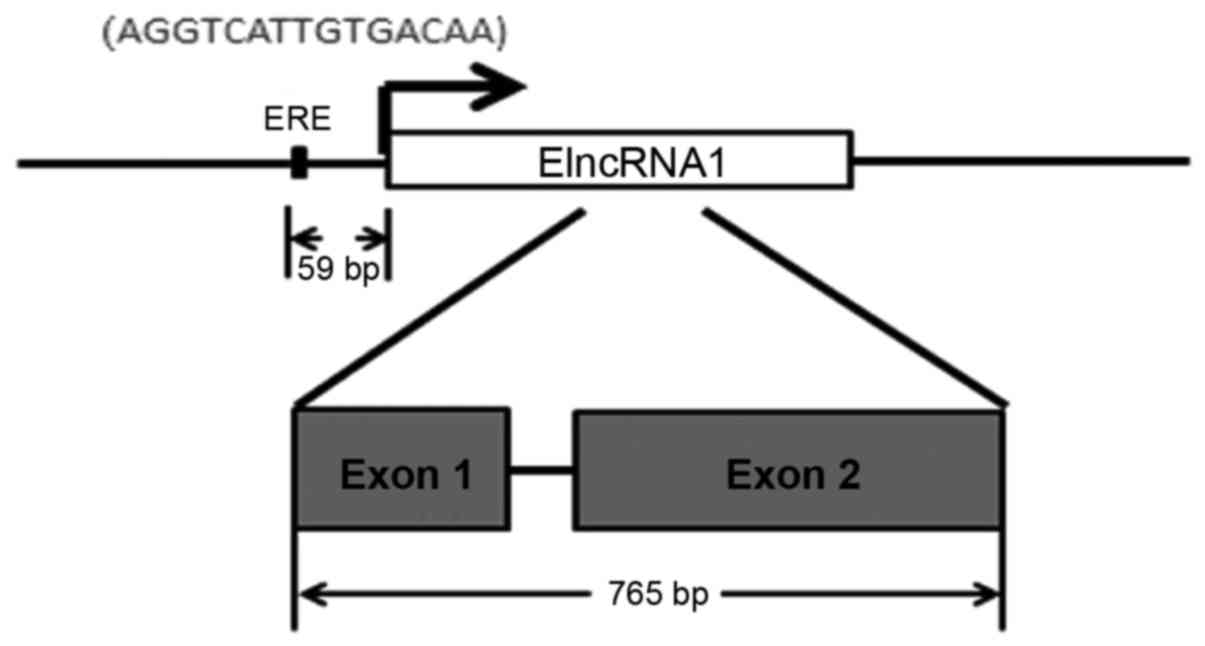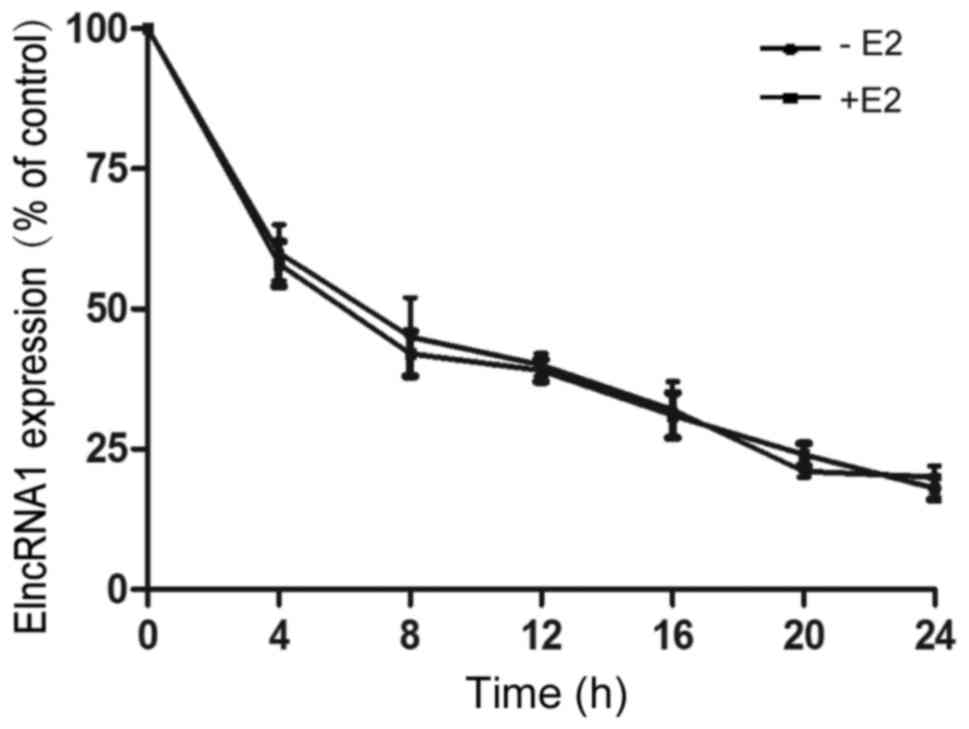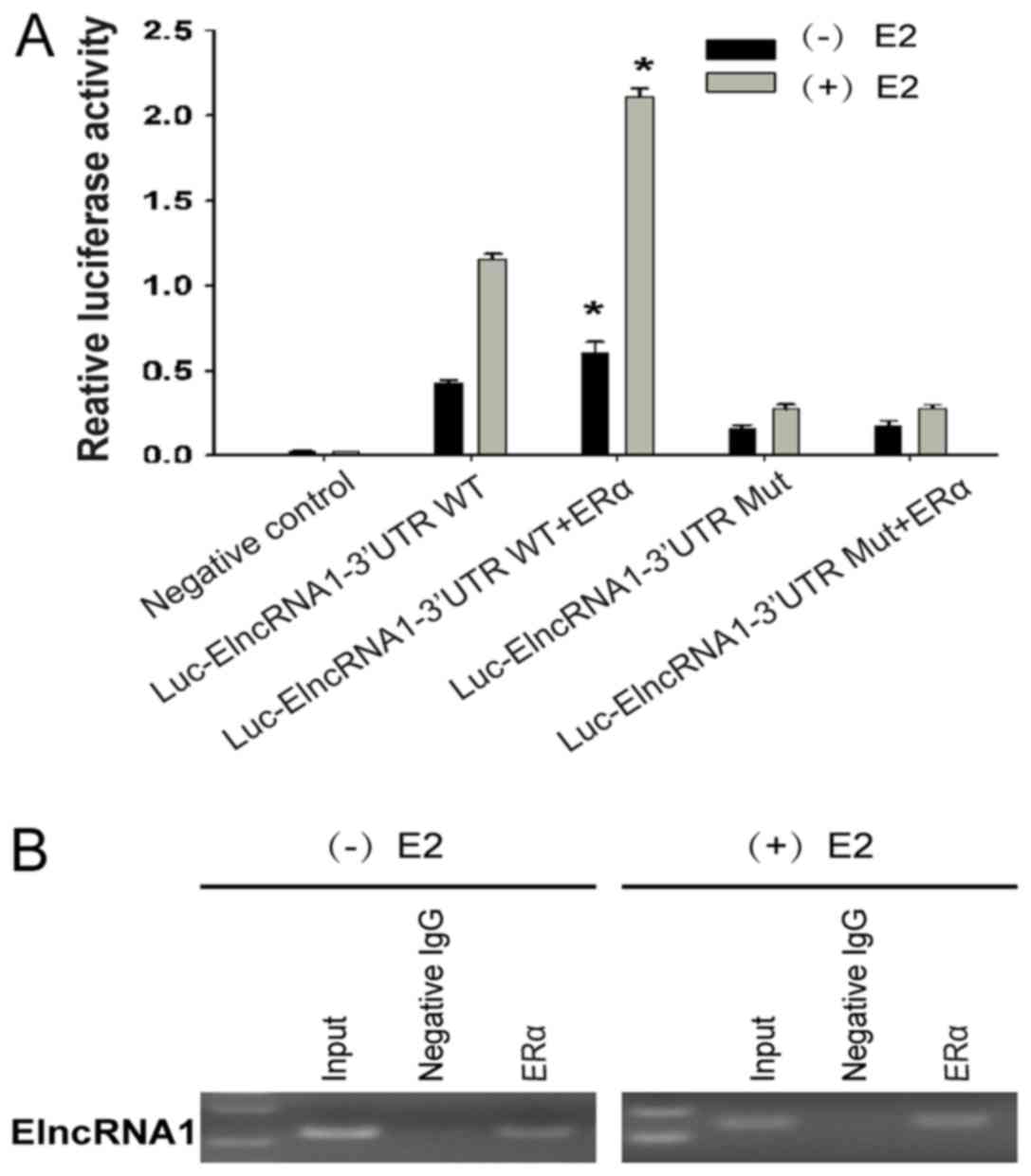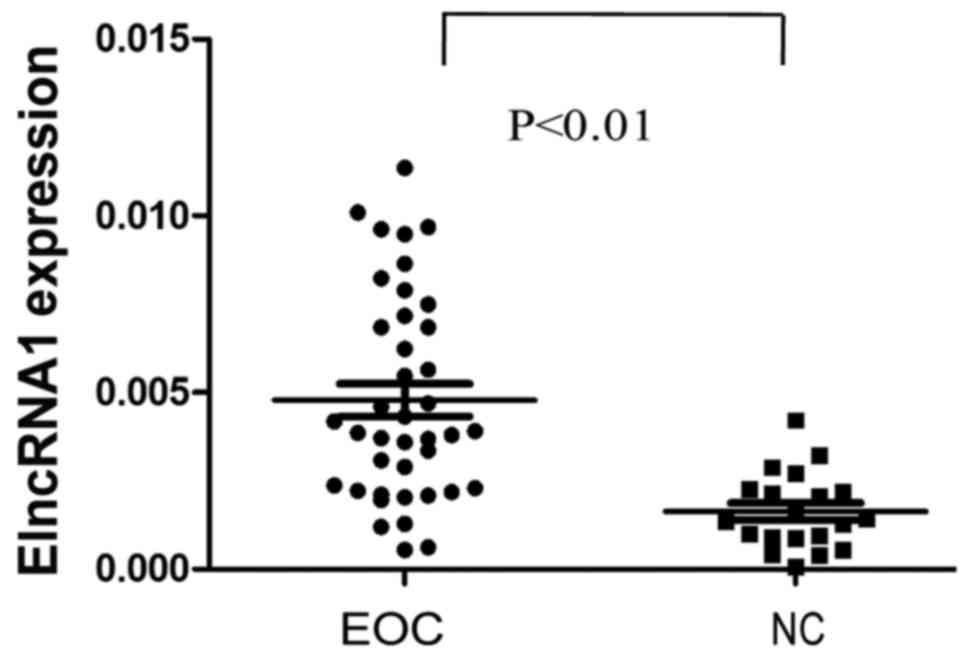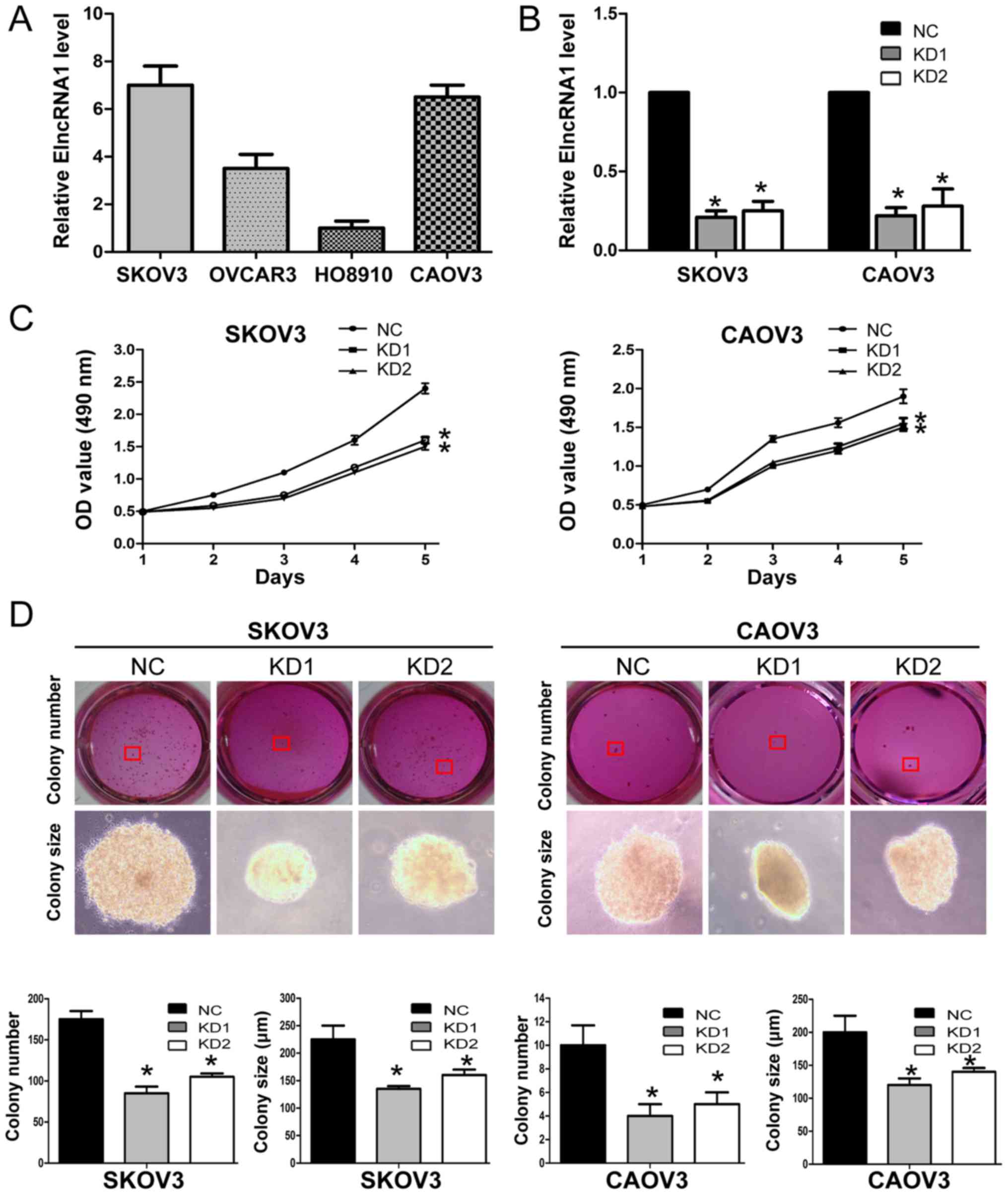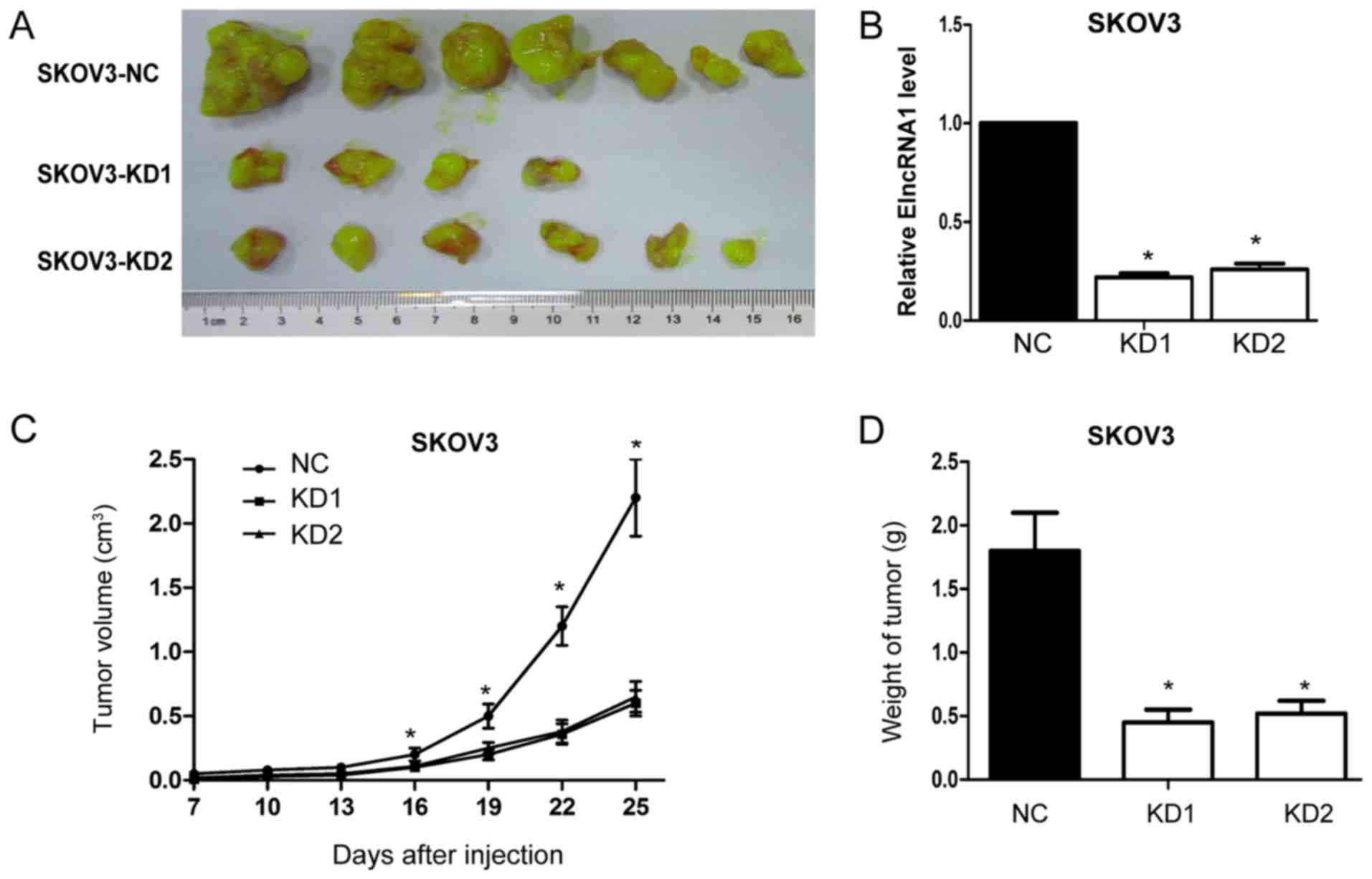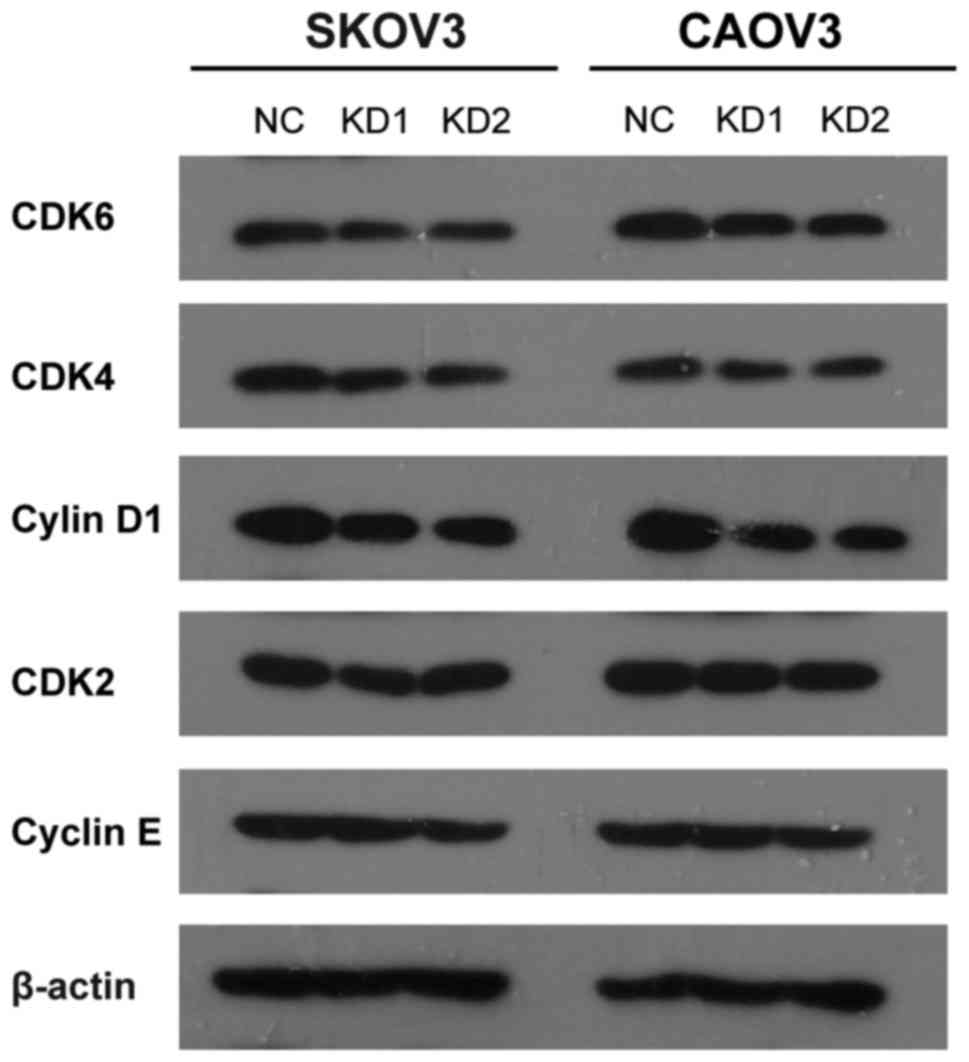ElncRNA1, a long non-coding RNA that is transcriptionally induced by oestrogen, promotes epithelial ovarian cancer cell proliferation
- Authors:
- Published online on: June 7, 2017 https://doi.org/10.3892/ijo.2017.4030
- Pages: 507-514
Abstract
Introduction
Epithelial ovarian cancer (EOC) is the leading cause of death from gynaecologic malignancies (1–3). EOC is highly lethal, primarily because it is diagnosed at an advanced stage and is characterized by aggressive proliferation and metastasis (2). Despite advances in therapy, the high mortality and poor prognosis associated with EOC remain unchanged (2). Therefore, identifying new therapeutic targets for EOC and understanding the molecular mechanisms underlying EOC aggressiveness will yield novel strategies for overcoming this malignancy.
Accumulating clinical and epidemiological evidence has shown that oestrogen (E2) is responsible for promoting ovarian cancer progression (4,5). In vitro and in vivo experimental data have indicated that E2 enhances EOC cell proliferation (6–11). The effects of E2 on EOC proliferation are mainly attributable to E2-regulated target genes. Previous studies have reported numerous E2-regulated proteins that affect EOC cell proliferation and progression, such as cyclin D1, c-myc and insulin-like growth factor-binding protein (IGFBP) family members (5,12). Despite the identification of these E2-regulated proteins, the exact effect of E2 on EOC progression is not fully understood. Therefore, there is an urgent need to identify novel E2-regulated target genes.
The discovery of long non-coding RNAs (lncRNAs, >200 nucleotides) has opened a new avenue in cancer research. Accumulating evidence highlights the importance of lncRNAs as a novel class of oncogenes or tumour suppressor genes in the development of many types of cancer (13–23), including EOC (24–28). Further, some lncRNAs have recently been reported to be involved in E2 signalling. For example, the lncRNA-SRA1 was reported to function as a nuclear receptor corepressor in E2 signalling (29), and HOTAIR is upregulated by E2 and contributes to E2-supported breast cancer progression (30,31). However, little is known about E2-regulated lncRNAs in ovarian cancer.
We previously identified a novel E2-upregulated lncRNA, TC0101441, based on microarray analysis and found that TC0101441 contributes to E2-induced EOC cell migration (32). However, the detailed mechanism by which E2 upregulates TC0101441 and the role of ElncRNA1 itself in EOC progression have not been elucidated. In the present study, we further evaluated TC0101441, designated as oestrogen-induced long non-coding RNA-1 (ElncRNA1), and showed that E2 upregulated ElncRNA1 at the transcriptional level through the oestrogen receptor α (ERα)-oestrogen response element (ERE) pathway. Clinically, ElncRNA1 levels were significantly higher in EOC tissues than in normal ovarian surface epithelial tissues. In vitro and in vivo assays revealed that ElncRNA1 promotes EOC cell proliferation. This pro-proliferation effect of ElncRNA1 was partially mediated by the regulation of CDK4, CDK6 and cyclin D1. These findings not only clarify the mechanism by which E2 upregulates ElncRNA1 but also underscore the important role of this novel E2-upregulated lncRNA in EOC proliferation, thus providing a connection between E2 and ovarian cancer from the perspective of lncRNA.
Materials and methods
Cell lines and clinical tissue samples
The human EOC cell lines (SKOV3, CAOV3, OVCAR3 and HO8910) were a gift from University of Texas MD Anderson Cancer Center (Houston, TX, USA). SKOV3, CAOV3 and HO8910 cells were cultured in RPMI-1640 (Gibco, Gaithersburg, MD, USA). OVCAR3 cells were maintained in McCoy's 5A supplemented with 10% foetal bovine serum (Gibco) at 37°C in a 5% CO2 atmosphere. For E2 treatment, cells (plated at 20–30% confluence) were grown for 3 days in phenol red-free RPMI-1640 or McCoy's 5A containing 5% charcoal-stripped foetal bovine serum (Serana, Bunbury, Australia). Next, the cells were treated for 24 h with 10−8 M E2 (Sigma) or vehicle (DMSO, 0.01% of final volume) as a control.
All tissue samples were obtained during surgical operations at the Obstetrics and Gynecology Hospital of Fudan University between August 2005 and December 2008. All EOC tissues were selected from patients who a) had not received preoperative radiotherapy, chemotherapy, or hormonal therapy; and b) did not have borderline ovarian tumours or two or more different malignancies. All 40 EOC tissues analysed herein were serous ovarian cancer tissues. In particular, according to the International Federation of Gynecologists and Obstetricians (FIGO) staging system, 6 cases were FIGO stage I, 6 cases were FIGO stage II, 24 cases were FIGO stage III, and 4 cases were FIGO stage IV. Additionally, according to histological grading guidelines, 6 cases were grade I (G1), 12 cases were G2, and 22 cases were G3. The normal ovarian epithelial tissues were obtained from participants diagnosed with uterine fibroids who were scheduled to undergo a hysterectomy and oophorectomy. Tissues were selected from participants who did not have a history of ovarian cysts, ovarian pathology, or ovarian surgery. All samples were pathologically confirmed, immediately frozen in liquid nitrogen and stored at −80°C. The study was approved by the Research Ethics Committee of Fudan University, China. Informed consent was obtained from each patient.
RNA extraction and quantitative real-time polymerase chain reaction (qRT-PCR)
Total RNA was isolated with TRIzol reagent (Invitrogen, Carlsbad, CA, USA) and then reverse transcribed into cDNA using the ExScript RT-PCR kit (Takara, Otsu, Japan) following the manu facturer's instructions. ElncRNA1 expression was measured by qRT-PCR using the following primer sequences: forward, 5′-CAAGGCAGGTGAGAACGAGT-3′; and reverse, 5′-CTCGACTTAGGGAGCTGCAC-3′. Expression of the internal control, glyceraldehyde 3-phosphate dehydrogenase (GAPDH), was measured with the following primers: forward, 5′-TGACTTCAACAGCGACACCCA-3′; and reverse, 5′-CACCCTGTTGCTGTAGCCAAA-3′. Amplification and detection were conducted using a Prism 7900 system (Applied Biosystems, Foster City, CA, USA) with the ExScript SYBR Green qRT-PCR kit (Takara). All assays were repeated in triplicate, and statistical analyses of the results were performed using the 2−ΔΔCt relative quantification method.
Sequence analysis of ElncRNA1
The gene location was obtained from the University of California Santa Cruz (UCSC) genome browser (hg18, http://genome.ucsc.edu/). The Basic Local Alignment Search Tool (BLAST) was used for sequence alignment, and the BLAST-Like Alignment Tool (BLAT) was used to map the cDNA to chromosomes.
RNA stability assay
To measure RNA half-life, we added 10 μg/ml actinomycin D (Sigma) to the cells to block transcription (nascent RNA synthesis). The cells were pre-treated with actinomycin D prior to E2 treatment. Total RNA was extracted from samples harvested at the indicated time points. ElncRNA1 expression was quantified by qRT-PCR. The half-life of ElncRNA1 RNA was calculated using data from two independent experiments.
Search for EREs
A region 2,500 bp upstream and 500 bp downstream of the transcriptional start site (TSS) was screened for transcription factor binding sites (TFBSs) using the Patser program (http://ural.wustl.edu/src/patser-v3e.1.tar.gz) and TRANSFAC 8.1 position weight matrices (PWMs) (http://www.gene-regulation.com/). A cut-off score of 0.9 was employed, and both the forward and reverse genomic DNA strands were investigated. EMBOSS/fuzznuc software (http://helixweb.nih.gov/emboss/html/fuzznuc.html) was used to evaluate the putative EREs in the E2-regulated lncRNA. The conserved ERE sequence is AGGTCAnnnTGACCT, and up to two mismatches were allowed.
Plasmids and luciferase assays
A firefly luciferase (Luc) reporter driven by a fragment of the 3′ untranslated regions (UTR) of ElncRNA1 containing the putative ERE [Luc-ElncRNA1-3′UTR wild-type (WT)] and a Luc reporter driven by a corresponding mutant sequence (Luc-ElncRNA1-3′UTR Mut) were synthesized. The primer sequences were as follows: sense for Luc-ElncRNA1-3′UTR WT and Luc-ElncRNA1-3′UTR Mut: GGGGTACCGTAGAGACAGGGTCTCACCACATT; antisense for Luc-ElncRNA1-3′UTR WT: CGACGCGTGGAGCATCTGTCCCAGCTG; and anti-sense for Luc-ElncRNA1-3′UTR Mut: CGACGCGTGGAGCATCTGTCCCAGCTGGAGTCCCCTGTGGTGTTATCTGAGATTCAGCAGCTCTGCAAGAATATCATCTATGAC. A plasmid expressing ERα was constructed by Hanyin Co. (Shanghai, China). A plasmid expressing Renilla Luc was purchased from Promega (Madison, WI, USA). SKOV3 cells were transfected with the above plasmids or vectors for 24 h and then treated with E2; Luc assays were performed after a 16 h E2 treatment using a Dual-Luciferase Assay kit (Promega) according to the manufacturer's protocol.
Chromatin immunoprecipitation (ChIP)
ChIP assays were performed using a ChIP assay kit (Millipore) according to the manufacturer's instruction. Specific antibodies were used to immunoprecipitate either ERα or the negative control IgG. Real-time PCR was performed using a SYBR Green PCR kit (Qiagen). The primer sequences for amplifying the ElncRNA1 promoter region flanking the ERα-ERE binding sites were as follows: forward, 5′-GGAAGAACAGCTCCGTGAAG-3′; and reverse, 5′-CAGATTCAGGGCTCTTGAGG-3′.
Establishment of stable ElncRNA1-knockdown cell lines
The two ElncRNA1-siRNA sequences were 5′-GCTCACATGAGAAAGCAAACT-3′ (siRNA1) and 5′-CUUGAGUUAUGAGGUAGCA-3′ (siRNA2). Lentiviral vectors encoding ElncRNA1-shRNA were designed based on the two siRNA se quences (ElncRNA1-knockdown (KD)1 and ElncRNA1-KD2) and were constructed by Hanyin Co. The recombinant lentiviruses (KD1 and KD2) and the negative control (NC) lentivirus (Hanyin Co.) were prepared at a titre of 109 transfection units (TU)/ml. To obtain stable cell lines, SKOV3 and CAOV3 cells were seeded in 6-well plates and infected with virus and polybrene the following day. Positive clones were selected with puromycin for 14 days to establish the following new stable cell lines: SKOV3-NC, SKOV3-KD1, SKOV3-KD2, CAOV3-NC, CAOV3-KD1 and CAOV3-KD2.
MTT assay
Cell proliferation was assayed using a 3-(4,5-dimethylthiazol-2-yl)-2,5-diphenyltetrazolium bromide (MTT) kit (Sigma-Aldrich, St. Louis, MO, USA) and a Synergy H4 Hybrid Reader. Briefly, the culture medium was removed after 1, 2, 3, 4, and 5 days; 0.5 mg/ml MTT in 200 μl of medium was added to each well; and the plates were incubated for 4 h. Then, 150 μl of DMSO was added to the SKOV3 and CAOV3 cells for 10 min, and the optical density (OD) was measured at 490 nm. Each experiment was repeated in triplicate.
Colony formation assay
Duplicate cultures of each cell type were maintained at 37°C in a 5% CO2 atmosphere, and fresh medium was added every 3 days. After 2 weeks, colonies in each well consisting of >50 cells were counted. Each experiment was repeated in triplicate.
Tumour formation in nude mice
The animal experiments were approved by the Institutional Animal Care and Use Committee of Fudan University and were performed according to the institutional guidelines and protocols. SKOV3-KD1, SKOV3-KD2, and SKOV3-NC cells (1×106) were subcutaneously injected into 5-week-old BALB/c athymic nude mice (Department of Laboratory Animals, Fudan University; n=7 for each cell line). The mice were sacrificed after 4 weeks and examined for the growth of subcutaneous tumours. The tumour volume was calculated as previously described (33).
Western blotting
Western blot assays were performed using the following primary antibodies: anti-cyclin E (Santa Cruz); anti-cyclin D1 (Cell Signaling Technology); anti-CDK2 (Abways Technology); anti-CDK4 (Abways Technology); anti-CDK6 (Abways Technology); and β-actin (Proteintech). Briefly, stimulated cells were lysed with RIPA buffer [50 mM Tris-HCl (pH 7.5), 150 mM NaCl, 1% Triton X-100, 0.5% Na-deoxycholate] containing protease inhibitors (Roche, Complete Mini); 20-30 μg samples of the lysates were separated on 8-12% SDS-PAGE gels and transferred to PVDF membranes. The membranes were incubated with primary antibodies overnight at 4°C. The primary antibody incubation was followed by incubation with an HRP-conjugated secondary antibody. The bound antibodies were detected using an ECL kit (Pierce).
Statistical analysis
The data were processed using SPSS version 16.0 software (SPSS, Inc., Chicago, IL, USA). Continuous data were compared between the two groups using independent t-tests. P-values at <0.05 were considered statistically significant.
Results
A novel E2-induced lncRNA, TC0101441/ElncRNA1
We previously identified a novel lncRNA, TC0101441, which was significantly upregulated by E2 in SKOV3 ERα-positive ovarian cancer cells (32). In this study, we designated TC0101441 as E2-induced lncRNA 1 (ElncRNA1). Based on a bioinformatics analysis using the UCSC genome browser (hg18, http://genome.ucsc.edu/), we noted that ElncRNA1 is located on chromosome 1 (chr1: 202,377,159:202,378,011), contains two exons and encodes a 765 bp lncRNA molecule (Fig. 1).
Effects of E2 on ElncRNA1 mRNA stability
To determine whether E2-mediated changes in ElncRNA1 levels are related to transcription or mRNA stability, we treated SKOV3 cells with actinomycin D to block nascent RNA synthesis prior to E2 treatment and measured ElncRNA1 levels at various subsequent time points. RNA stability was not significantly altered in SKOV3 cells in the absence or presence of E2 (Fig. 2). This result suggests that the E2-mediated changes in ElncRNA1 levels are not due to altered mRNA stability and implies that transcriptional regulation may be a major mechanism by which ElncRNA1 is induced.
ERα-ERE binding is required for transcriptional regulation of ElncRNA1 expression by E2
Given the results of our prior study, which demonstrated that E2 induced ElncRNA1 expression in an ERα-dependent manner (32), we next screened the ElncRNA1 promoter for the presence of ERα-responsive elements to confirm the transcriptional upregulation of ElncRNA1 by E2. We identified a predicted ERE (−1725 to −1711) in a region 59 bp upstream of the TSS of ElncRNA1 (Fig. 1). We subsequently transfected SKOV3 cells with ERα and ElncRNA1 promoter reporters containing a mutated or wild-type (WT) ERE and then measured Luc activity after E2 treatment. Cells expressing both WT ERE and ERα responded strongly to E2 by inducing reporter activity (Fig. 3A), suggesting that both ERα and ERE are required for E2 to upregulate ElncRNA1 expression.
We subsequently performed ChIP assays with antibodies against ERα to confirm that ERα binds to the ERE region of the ElncRNA1 promoter. As shown in Fig. 3B, enrichment of ERα-associated promoter fragments was confirmed by RT-PCR, and this enrichment was enhanced by E2. These results indicate that ERα can bind to the ERE in the ElncRNA1 promoter in a manner that is enhanced by E2 treatment, thus inducing ElncRNA1 expression.
ElncRNA1 expression pattern in EOC tissues
To investigate whether ElncRNA1 has clinical implications, we used qRT-PCR to determine the ElncRNA1 expression pattern in EOC. ElncRNA1 levels were significantly higher in 40 EOC tissues than in 20 normal ovarian surface epithelial tissues (P<0.01; Fig. 4). These results suggest that ElncRNA1 over-expression may play a role in EOC aggressiveness.
Silencing ElncRNA1 suppresses EOC cell proliferation in vitro
To determine whether ElncRNA1 affects EOC cell proliferation, we first examined the basal levels of ElncRNA1 in 4 EOC cell lines (SKOV3, CAOV3, OVCAR3 and HO8910) and found that SKOV3 and CAOV3 cells expressed relatively higher ElncRNA1 levels (Fig. 5A). Thus, we silenced ElncRNA1 expression in these two cell lines to investigate the effects of ElncRNA1 on cell proliferation. Since both siRNAs efficiently silenced ElncRNA1 expression in SKOV3 and CAOV3 cells (Fig. 5B), we constructed lentiviral vectors to establish stable ElncRNA1-knockdown cell lines (SKOV3-KD1, SKOV3-KD2, CAOV3-KD1, and CAOV3-KD2 cells) and corresponding controls (SKOV3-NC and CAOV3-NC cells).
MTT assays showed that ElncRNA1 knockdown significantly suppressed the proliferation of both SKOV3 and CAOV3 cells (Fig. 5C). Colony formation assays demonstrated that ElncRNA1 knockdown reduced the number of SKOV3 and CAOV3 colonies (Fig. 5D). These results indicate that silencing ElncRNA1 may inhibit EOC cell proliferation in vitro.
Silencing ElncRNA1 inhibits EOC tumour growth in vivo
Next, we tested the effects of ElncRNA1 on EOC tumour growth in vivo by injecting SKOV3-KD1, SKOV3-KD2 and SKOV3-NC cells into nude mice. ElncRNA1 knockdown reduced the frequency of tumour formation (SKOV3-NC, 7/7; SKOV3-KD1, 4/7; and SKOV3-KD2, 6/7) (Fig. 6A). Moreover, qRT-PCR analysis confirmed that ElncRNA1 expression levels were significantly lower in tumour tissues from the ElncRNA1-KD group relative to those from the control group (Fig. 6B). Further, the volume and average weight of tumours formed by SKOV3-KD1 and SKOV3-KD2 cells were much lower compared to tumours formed by SKOV3-NC cells (Fig. 6C). Together, these results suggest that silencing ElncRNA1 inhibits EOC growth in vivo, which corresponds with the in vitro results.
Certain proliferation-related proteins are downstream mediators of ElncRNA1 activity affecting EOC cell proliferation
To study possible mechanisms through which ElncRNA1 alters EOC cell proliferation further, we evaluated the expression of certain key proliferation-related proteins, including cyclin D1, cyclin E, CDK2, CDK4, CDK6, by western blot assay. The results showed that ElncRNA1 knockdown in SKOV3 and CAOV3 cells resulted in a significant decrease in CDK4, CDK6 and cyclin D1 protein levels (Fig. 7), suggesting that CDK4, CDK6 and cyclin D1 are the downstream mediators of ElncRNA1 activity affecting EOC cell proliferation. Together, these data indicate that ElncRNA1 regulates EOC cell proliferation at least in part by regulating CDK4, CDK6 and cyclin D1.
Discussion
Previously, we identified the novel E2-upregulated lncRNA, ElncRNA1, based on microarray analysis. However, the detailed mechanisms by which E2 upregulates ElncRNA1 and the role of ElncRNA1 itself in EOC progression have not been determined (32). In the present study, using RNA stability assays, bioinformatics-based searches for ERE binding sites, ChIP assays and dual luciferase reporter assays, we found that E2 transcriptionally upregulated ElncRNA1 through the ERα-ERE pathway. Clinically, ElncRNA1 levels were significantly higher in EOC tissues than in normal ovarian surface epithelial tissues. Further in vitro and in vivo assays revealed that ElncRNA1 promoted EOC cell proliferation. This pro-proliferation effect of ElncRNA1 was partially mediated by the regulation of CDK4, CDK6 and cyclin D1. Together, these findings not only clarify the mechanism by which E2 upregulates ElncRNA1 but also underscore the important role of this novel E2-upregulated lncRNA in EOC proliferation, thus providing a connection between E2 and ovarian cancer from the perspective of lncRNA.
E2 plays an important role in regulating cancer growth through various target genes, including protein coding genes and non-coding RNAs. We previously identified a novel E2-upregulated lncRNA (TC0101441, designated ElncRNA1) (32), but the molecular mechanisms by which E2 upregulates ElncRNA1 have not been determined. So far, several mechanisms have been proposed for E2-regulated gene expression, including direct action of basal transcriptional elements and the participation of cofactors (34-36). Our prior study demonstrated that the E2-mediated induction of ElncRNA1 expression is dependent on ERα (32), a ligand-activated transcription factor in the nuclear receptor super-family that directly binds to oestrogen-responsive elements (EREs) in the promoter regions of target genes, thereby regulating their transcription (34,36,37). Therefore, we hypothesized that ERα-ERE binding might contribute to the transcriptional upregulation of ElncRNA1 expression by E2. To address this hypothesis, we initially performed mRNA stability experiments. The use of actinomycin D suggested that the E2-induced changes in ElncRNA1 expression were not due to effects on mRNA stability but were rather due to changes in E2-regulated transcription. To confirm the transcriptional upregulation of ElncRNA1 by E2, we screened the ElncRNA1 promoter and found an ERE in a 59 bp region upstream of the TSS of ElncRNA1. Subsequent ChIP assays indicated that ERα bound to the ERE in the ElncRNA1 promoter. Moreover, dual luciferase reporter assays revealed that cells expressing both WT ERE and ERα responded strongly to E2 by inducing reporter activity, suggesting that both ERα and ERE are required for E2 to upregulate ElncRNA1 expression. Together, these findings indicate that E2 acts through its nuclear receptor ERα, which binds directly to ERE in the promoter region of ElncRNA1, thereby inducing transcriptional upregulation of ElncRNA1 expression. Additionally, we can conclude that E2 transcriptionally upregulates ElncRNA1 through the ERα-ERE pathway.
However, the role of this novel E2-upregulated lncRNA, ElncRNA1, remained to be determined. Accumulating evidence indicates that aberrantly expressed lncRNAs play oncogenic or tumour suppressor roles in human cancer. For example, HOTAIR promotes tumour growth in cervical cancer (38), and MEG3 inhibits cell proliferation in prostate cancer (39). As lncRNAs are emerging as key components of cancer progression, it was reasonable to hypothesize that ElncRNA1 may contribute to EOC progression. Our previous work showed that ElncRNA1 contributes to E2-induced EOC metastasis. However, the role of ElncRNA1 itself in EOC has not been determined, and an association between ElncRNA1 and aspects of EOC progression other than metastasis has not been demonstrated. In the present study, ElncRNA1 levels were clearly higher in EOC tissues than in noncancerous tissues, suggesting that ElncRNA1 may play a role in the aggressiveness of EOC. In vitro, ElncRNA1 knockdown suppressed cell proliferation and reduced the number of SKOV3 and CAOV3 colonies. Additionally, in vivo experiments confirmed that ElncRNA1 depletion inhibited tumour growth in nude mice. Taken together, these data suggest that ElncRNA1 plays an important role in promoting EOC growth and can function as an oncogene, thereby contributing to the proliferative effects of E2.
Previous study demonstrated that the key proliferation-related genes 'cyclin D1-CDK4/6', associated with E2/ER signaling pathway, promoted breast cancer proliferation (40). In the present study, we found that ElncRNA1 knockdown in SKOV3 and CAOV3 cells resulted in a significant decrease in CDK4, CDK6 and cyclin D1 protein levels instead of cyclin E and CDK2 levels, suggesting that ElncRNA1 regulates EOC cell proliferation at least in part by regulating 'cyclin D1-CDK4/6'. One limitation of this study is that we did not study the exact mechanism by which ElncRNA1 regulates cyclin D1-CDK4/6 in EOC growth. Further studies are required to explore the exact molecular mechanism of E2/ERα- ElncRNA1-'cyclin D1-CDK4/6' pathway.
In conclusion, our study provides the first evidence that E2 transcriptionally upregulates ElncRNA1 through the ERα-ERE pathway and that this novel E2-upregulated lncRNA has an oncogenic role in EOC growth. The addition of ElncRNA1 to the E2-ERα-ERE signalling pathway may provide greater insight into the oestrogenic effects on EOC progression from the perspective of lncRNA.
Acknowledgments
This study was supported by funding from the National Natural Science Foundation of China (81370689 and 81571404; to K.-Q.H.), the National Natural Science Foundation for Young Scholars of China (81502240; to J.-J.Q.), and the Shanghai Science and Technology Development Funds for the Talents (15YF1401400; to J.-J.Q.).
References
|
Hollis RL and Gourley C: Genetic and molecular changes in ovarian cancer. Cancer Biol Med. 13:236–247. 2016. View Article : Google Scholar : PubMed/NCBI | |
|
Doubeni CA, Doubeni AR and Myers AE: Diagnosis and management of ovarian cancer. Am Fam Physician. 93:937–944. 2016.PubMed/NCBI | |
|
Siegel RL, Miller KD and Jemal A: Cancer statistics, 2016. CA Cancer J Clin. 66:7–30. 2016. View Article : Google Scholar : PubMed/NCBI | |
|
Tsilidis KK, Allen NE, Key TJ, Dossus L, Kaaks R, Bakken K, Lund E, Fournier A, Dahm CC, Overvad K, et al: Menopausal hormone therapy and risk of ovarian cancer in the European prospective investigation into cancer and nutrition. Cancer Causes Control. 22:1075–1084. 2011. View Article : Google Scholar : PubMed/NCBI | |
|
Cunat S, Hoffmann P and Pujol P: Estrogens and epithelial ovarian cancer. Gynecol Oncol. 94:25–32. 2004. View Article : Google Scholar : PubMed/NCBI | |
|
Park SH, Cheung LW, Wong AS and Leung PC: Estrogen regulates Snail and Slug in the down-regulation of E-cadherin and induces metastatic potential of ovarian cancer cells through estrogen receptor alpha. Mol Endocrinol. 22:2085–2098. 2008. View Article : Google Scholar : PubMed/NCBI | |
|
Hua K, Din J, Cao Q, Feng W, Zhang Y, Yao L, Huang Y, Zhao Y and Feng Y: Estrogen and progestin regulate HIF-1α expression in ovarian cancer cell lines via the activation of Akt signaling transduction pathway. Oncol Rep. 21:893–898. 2009.PubMed/NCBI | |
|
Hua K, Feng W, Cao Q, Zhou X, Lu X and Feng Y: Estrogen and progestin regulate metastasis through the PI3K/AKT pathway in human ovarian cancer. Int J Oncol. 33:959–967. 2008.PubMed/NCBI | |
|
Ding JX, Feng YJ, Yao LQ, Yu M, Jin HY and Yin LH: The reinforcement of invasion in epithelial ovarian cancer cells by 17 beta-Estradiol is associated with up-regulation of Snail. Gynecol Oncol. 103:623–630. 2006. View Article : Google Scholar : PubMed/NCBI | |
|
Spillman MA, Manning NG, Dye WW, Sartorius CA, Post MD, Harrell JC, Jacobsen BM and Horwitz KB: Tissue-specific pathways for estrogen regulation of ovarian cancer growth and metastasis. Cancer Res. 70:8927–8936. 2010. View Article : Google Scholar : PubMed/NCBI | |
|
Laviolette LA, Garson K, Macdonald EA, Senterman MK, Courville K, Crane CA and Vanderhyden BC: 17beta-estradiol accelerates tumor onset and decreases survival in a transgenic mouse model of ovarian cancer. Endocrinology. 151:929–938. 2010. View Article : Google Scholar : PubMed/NCBI | |
|
O'Donnell AJ, Macleod KG, Burns DJ, Smyth JF and Langdon SP: Estrogen receptor-alpha mediates gene expression changes and growth response in ovarian cancer cells exposed to estrogen. Endocr Relat Cancer. 12:851–866. 2005. View Article : Google Scholar : PubMed/NCBI | |
|
Gutschner T, Hämmerle M, Eissmann M, Hsu J, Kim Y, Hung G, Revenko A, Arun G, Stentrup M, Gross M, et al: The noncoding RNA MALAT1 is a critical regulator of the metastasis phenotype of lung cancer cells. Cancer Res. 73:1180–1189. 2013. View Article : Google Scholar | |
|
Du Y, Kong G, You X, Zhang S, Zhang T, Gao Y, Ye L and Zhang X: Elevation of highly up-regulated in liver cancer (HULC) by hepatitis B virus X protein promotes hepatoma cell proliferation via down-regulating p18. J Biol Chem. 287:26302–26311. 2012. View Article : Google Scholar : PubMed/NCBI | |
|
Gupta RA, Shah N, Wang KC, Kim J, Horlings HM, Wong DJ, Tsai MC, Hung T, Argani P, Rinn JL, et al: Long non-coding RNA HOTAIR reprograms chromatin state to promote cancer metastasis. Nature. 464:1071–1076. 2010. View Article : Google Scholar : PubMed/NCBI | |
|
Matouk IJ, DeGroot N, Mezan S, Ayesh S, Abu-lail R, Hochberg A and Galun E: The H19 non-coding RNA is essential for human tumor growth. PLoS One. 2:e8452007. View Article : Google Scholar : PubMed/NCBI | |
|
Huarte M, Guttman M, Feldser D, Garber M, Koziol MJ, Kenzelmann-Broz D, Khalil AM, Zuk O, Amit I, Rabani M, et al: A large intergenic noncoding RNA induced by p53 mediates global gene repression in the p53 response. Cell. 142:409–419. 2010. View Article : Google Scholar : PubMed/NCBI | |
|
Zhou Y, Zhang X and Klibanski A: MEG3 noncoding RNA: A tumor suppressor. J Mol Endocrinol. 48:R45–R53. 2012. View Article : Google Scholar : PubMed/NCBI | |
|
Qiao HP, Gao WS, Huo JX and Yang ZS: Long non-coding RNA GAS5 functions as a tumor suppressor in renal cell carcinoma. Asian Pac J Cancer Prev. 14:1077–1082. 2013. View Article : Google Scholar : PubMed/NCBI | |
|
Fang J, Sun CC and Gong C: Long noncoding RNA XIST acts as an oncogene in non-small cell lung cancer by epigenetically repressing KLF2 expression. Biochem Biophys Res Commun. 478:811–817. 2016. View Article : Google Scholar : PubMed/NCBI | |
|
Li J, Yu H, Xi M and Lu X: Long noncoding RNA C17orf91 is a potential prognostic marker and functions as an oncogene in ovarian cancer. J Ovarian Res. 9:492016. View Article : Google Scholar : PubMed/NCBI | |
|
Liao T, Qu N, Shi RL, Guo K, Ma B, Cao YM, Xiang J, Lu ZW, Zhu YX, Li DS, et al: BRAF-activated LncRNA functions as a tumor suppressor in papillary thyroid cancer. Oncotarget. 8:238–247. 2017. | |
|
Sang Y, Zhou F, Wang D, Bi X, Liu X, Hao Z, Li Q and Zhang W: Up-regulation of long non-coding HOTTIP functions as an oncogene by regulating HOXA13 in non-small cell lung cancer. Am J Transl Res. 8:2022–2032. 2016.PubMed/NCBI | |
|
Tanos V, Prus D, Ayesh S, Weinstein D, Tykocinski ML, De-Groot N, Hochberg A and Ariel I: Expression of the imprinted H19 oncofetal RNA in epithelial ovarian cancer. Eur J Obstet Gynecol Reprod Biol. 85:7–11. 1999. View Article : Google Scholar : PubMed/NCBI | |
|
Rangel LB, Sherman-Baust CA, Wernyj RP, Schwartz DR, Cho KR and Morin PJ: Characterization of novel human ovarian cancer-specific transcripts (HOSTs) identified by serial analysis of gene expression. Oncogene. 22:7225–7232. 2003. View Article : Google Scholar : PubMed/NCBI | |
|
Silva JM, Boczek NJ, Berres MW, Ma X and Smith DI: LSINCT5 is over expressed in breast and ovarian cancer and affects cellular proliferation. RNA Biol. 8:496–505. 2011. View Article : Google Scholar : PubMed/NCBI | |
|
Qiu JJ, Wang Y, Liu YL, Zhang Y, Ding JX and Hua KQ: The long non-coding RNA ANRIL promotes proliferation and cell cycle progression and inhibits apoptosis and senescence in epithelial ovarian cancer. Oncotarget. 7:32478–32492. 2016.PubMed/NCBI | |
|
Qiu JJ, Lin YY, Ye LC, Ding JX, Feng WW, Jin HY, Zhang Y, Li Q and Hua KQ: Overexpression of long non-coding RNA HOTAIR predicts poor patient prognosis and promotes tumor metastasis in epithelial ovarian cancer. Gynecol Oncol. 134:121–128. 2014. View Article : Google Scholar : PubMed/NCBI | |
|
Chooniedass-Kothari S, Vincett D, Yan Y, Cooper C, Hamedani MK, Myal Y and Leygue E: The protein encoded by the functional steroid receptor RNA activator is a new modulator of ER alpha transcriptional activity. FEBS Lett. 584:1174–1180. 2010. View Article : Google Scholar : PubMed/NCBI | |
|
Bhan A and Mandal SS: Estradiol-induced transcriptional regulation of Long non-coding RNA, HOTAIR. Methods Mol Biol. 1366:395–412. 2016. View Article : Google Scholar | |
|
Xue X, Yang YA, Zhang A, Fong KW, Kim J, Song B, Li S, Zhao JC and Yu J: LncRNA HOTAIR enhances ER signaling and confers tamoxifen resistance in breast cancer. Oncogene. 35:2746–2755. 2016. View Article : Google Scholar : | |
|
Qiu J, Ye L, Ding J, Feng W, Zhang Y, Lv T, Wang J and Hua K: Effects of oestrogen on long noncoding RNA expression in oestrogen receptor alpha-positive ovarian cancer cells. J Steroid Biochem Mol Biol. 141:60–70. 2014. View Article : Google Scholar : PubMed/NCBI | |
|
Wang Y, Wang Z, Qi Z, Yin S, Zhang N, Liu Y, Liu M, Meng J, Zang R, Zhang Z, et al: The negative interplay between Aurora A/B and BRCA1/2 controls cancer cell growth and tumorigenesis via distinct regulation of cell cycle progression, cytokinesis, and tetraploidy. Mol Cancer. 13:942014. View Article : Google Scholar : PubMed/NCBI | |
|
Lin CY, Vega VB, Thomsen JS, Zhang T, Kong SL, Xie M, Chiu KP, Lipovich L, Barnett DH, Stossi F, et al: Whole-genome cartography of estrogen receptor alpha binding sites. PLoS Genet. 3:e872007. View Article : Google Scholar : PubMed/NCBI | |
|
Kushner PJ, Agard DA, Greene GL, Scanlan TS, Shiau AK, Uht RM and Webb P: Estrogen receptor pathways to AP-1. J Steroid Biochem Mol Biol. 74:311–317. 2000. View Article : Google Scholar | |
|
Carroll JS, Meyer CA, Song J, Li W, Geistlinger TR, Eeckhoute J, Brodsky AS, Keeton EK, Fertuck KC, Hall GF, et al: Genome-wide analysis of estrogen receptor binding sites. Nat Genet. 38:1289–1297. 2006. View Article : Google Scholar : PubMed/NCBI | |
|
Huang Y, Li X and Muyan M: Estrogen receptors similarly mediate the effects of 17β-estradiol on cellular responses but differ in their potencies. Endocrine. 39:48–61. 2011. View Article : Google Scholar | |
|
Lee M, Kim HJ, Kim SW, Park SA, Chun KH, Cho NH, Song YS and Kim YT: The long non-coding RNA HOTAIR increases tumour growth and invasion in cervical cancer by targeting the Notch pathway. Oncotarget. 7:44558–44571. 2016.PubMed/NCBI | |
|
Luo G, Wang M, Wu X, Tao D, Xiao X, Wang L, Min F, Zeng F and Jiang G: Long non-coding RNA MEG3 inhibits cell proliferation and induces apoptosis in prostate cancer. Cell Physiol Biochem. 37:2209–2220. 2015. View Article : Google Scholar : PubMed/NCBI | |
|
Herrera-Abreu MT, Palafox M, Asghar U, Rivas MA, Cutts RJ, Garcia-Murillas I, Pearson A, Guzman M, Rodriguez O, Grueso J, et al: Early adaptation and acquired resistance to CDK4/6 inhibition in estrogen receptor-positive breast cancer. Cancer Res. 76:2301–2313. 2016. View Article : Google Scholar : PubMed/NCBI |



